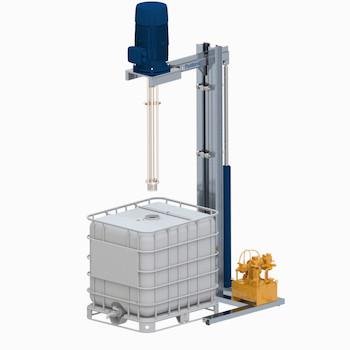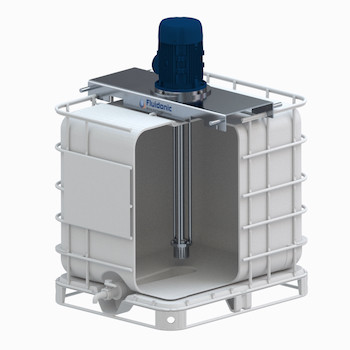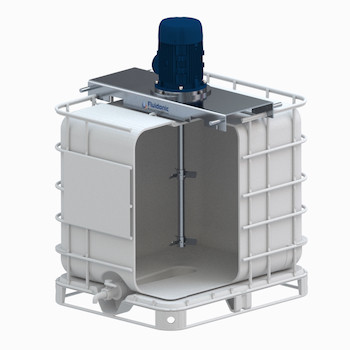Function and Working Principles of Tote Mixers
Tote mixers, also known as IBC (Intermediate Bulk Container) mixers, serve the purpose of blending and homogenizing liquids within the IBC containers. They are commonly used in various industries for applications such as chemical mixing, pharmaceutical formulations, food and beverage production, cosmetics manufacturing, and more. Here's an overview of the function and working principle of tote mixers:
Function:
The primary function of tote mixers is to homogenize and blend liquids stored in IBC containers. These mixers are designed to:
-
Ensure Homogeneity:
- Tote mixers create a uniform mixture by thoroughly blending the contents of the IBC container. This is crucial for industries where consistent product quality is required.
-
Prevent Stratification:
- They prevent the separation of components and ensure that any settled particles or ingredients are re-suspended throughout the liquid, preventing uneven distribution.
-
Improve Dissolution:
- Tote mixers facilitate the dissolution of solids or powders into liquids, ensuring that all components are fully incorporated.
-
Enhance Process Efficiency:
- By providing efficient mixing directly within the container, tote mixers reduce the need for additional transfer steps, saving time and resources.
Working Principle:
The working principle of tote mixers involves the use of agitation to create fluid motion within the IBC container. The specific design may vary, but the general working principle includes:
-
Agitation Mechanism:
- Tote mixers are equipped with an agitation mechanism, which can be in the form of impellers, propellers, or other agitating elements. The choice of agitation system depends on the viscosity and characteristics of the materials being mixed.
-
Variable Speed Control:
- Tote mixers typically come with variable speed controls. The operator can adjust the mixing speed based on the material's properties, ensuring optimal blending without causing excessive shear.
-
Installation:
- Tote mixers are installed directly into the IBC container. The mixing head or agitator is lowered into the liquid, and the mixer is secured to the IBC container.
-
Activation:
- The mixer is activated, and the agitator begins to rotate. The rotation of the agitator generates fluid motion, creating turbulence and ensuring the thorough mixing of the liquid.
-
Homogenization:
- As the agitator moves through the liquid, it imparts shear forces that break down clumps, disperse particles, and promote homogeneity. This is particularly important when dealing with materials that tend to settle or stratify.
-
Adjustable Mixing Parameters:
- The operator can adjust the mixing parameters, including speed and mixing time, to meet the specific requirements of the process.
-
Safety Features:
- Tote mixers are designed with safety features, such as emergency stops and protective guards, to ensure operator safety during operation.
-
Cleaning:
- After the mixing process, the tote mixer can be lifted out of the container for cleaning or moved to another container if necessary. Some models may come with Cleaning-in-Place (CIP) systems for automated cleaning.
Overall, the working principle of tote mixers revolves around creating controlled fluid motion within the IBC container to achieve efficient and uniform mixing of liquids and suspended solids. The design and functionality of tote mixers may vary, and specific models may have additional features to cater to diverse industry needs.
Applications:
-
Chemical Industry:
- Tote mixers are used for blending chemicals, solvents, and additives to ensure uniform composition.
-
Pharmaceuticals:
- In the pharmaceutical industry, tote mixers are employed for mixing and blending ingredients in the production of pharmaceutical formulations.
-
Food and Beverage:
- Used for mixing ingredients in the food and beverage industry, including liquids, syrups, and concentrates.
-
Cosmetics and Personal Care:
- Tote mixers facilitate the blending of cosmetic ingredients such as lotions, creams, and liquid products.
-
Water Treatment:
- Applied in water treatment processes for the mixing of chemicals or additives for purification and treatment.
-
Adhesives and Sealants:
- Tote mixers are used for blending adhesives, sealants, and other viscous materials in the manufacturing process.
-
Petrochemical Industry:
- Employed for mixing and blending various petrochemical products, including fuels and lubricants.
-
Paints and Coatings:
- Used in the production of paints and coatings to ensure the proper dispersion of pigments and additives.
-
Agrochemicals:
- Tote mixers play a role in the blending of fertilizers, pesticides, and other agrochemical products.
-
Biotechnology and Fermentation:
- In bioprocessing applications, tote mixers are utilized for the blending of cell culture media and other bioprocess solutions.


